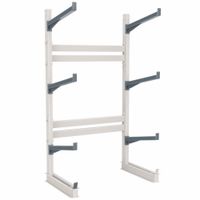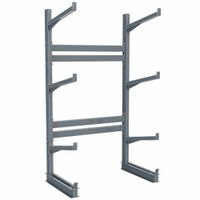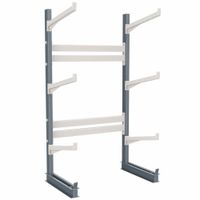Call +(254) 703 030 000 / 751 483 999 / 721 704 777
- Home
- Material Handling
- Storage Workspace
- Shelving Storage Racks
- Cantilever Racks Components
.....Read More
Frequently Asked Questions
What are cantilever racks used for?
Cantilever racks are storage systems designed to hold long, bulky, or irregularly shaped items that traditional shelving cannot accommodate. They consist of a series of vertical columns with horizontal arms extending outward, providing open-front storage that allows for easy loading and unloading. These racks are particularly useful in warehouses, manufacturing facilities, lumber yards, and retail environments.
The primary use of cantilever racks is to store items such as lumber, pipes, steel bars, furniture, and other materials that require unobstructed access. The design of cantilever racks allows for the storage of items of varying lengths without the need for vertical support columns in the way, which maximizes storage space and improves accessibility.
Cantilever racks are highly customizable, with adjustable arms that can be repositioned to accommodate different product sizes and weights. This flexibility makes them ideal for businesses that handle a diverse range of products. They can be configured as single-sided or double-sided units, depending on the available space and storage needs.
In addition to their versatility, cantilever racks enhance operational efficiency by allowing for quick and easy retrieval of stored items. Forklifts and other material handling equipment can easily access the racks, reducing the time and labor required for loading and unloading.
Overall, cantilever racks are an essential storage solution for industries that deal with long or oversized items, providing a practical, efficient, and space-saving method to organize and store materials.
How do you assemble a cantilever rack?
1. **Site Preparation**: Ensure the installation area is clean, level, and free of obstructions.
2. **Unpack Components**: Lay out all parts, including uprights, arms, bases, braces, and hardware.
3. **Install Bases**: Position the bases on the floor where the uprights will stand. Secure them using anchor bolts if required.
4. **Attach Uprights**: Connect the uprights to the bases. Ensure they are vertical and secure them with bolts.
5. **Install Braces**: Attach horizontal and diagonal braces between uprights to provide stability. Use the appropriate bolts and ensure they are tightly fastened.
6. **Attach Arms**: Secure the arms to the uprights at the desired height using bolts. Ensure they are level and evenly spaced.
7. **Check Alignment**: Verify that all components are aligned and level. Adjust as necessary.
8. **Tighten Bolts**: Once everything is aligned, tighten all bolts to ensure stability.
9. **Safety Check**: Inspect the entire structure for stability and ensure all components are securely fastened.
10. **Load Test**: Gradually load the rack to ensure it can handle the intended weight without issues.
What are the components of a cantilever rack?
A cantilever rack is a type of storage system designed to store long, bulky, or irregularly shaped items. Its components include:
1. **Base**: The foundation of the rack, providing stability and support. It is typically bolted to the floor to ensure the rack remains secure.
2. **Uprights/Columns**: Vertical supports that determine the height of the rack. They are attached to the base and support the arms.
3. **Arms**: Horizontal beams extending from the uprights, designed to hold the stored items. They can be adjusted to different heights and are available in various lengths and weight capacities.
4. **Braces**: Horizontal and diagonal components that connect the uprights, providing additional stability and rigidity to the structure. They help maintain the alignment and integrity of the rack.
5. **Arm Stops/End Stops**: Optional components attached to the ends of the arms to prevent items from rolling or sliding off.
6. **Decking**: Optional horizontal surfaces placed on the arms to create a shelf-like structure, allowing for the storage of smaller items.
7. **Bolts and Fasteners**: Used to assemble and secure the various components of the rack, ensuring stability and safety.
8. **Cantilever Brackets**: Optional components that can be used to support additional arms or decking, providing more versatility in storage configurations.
These components work together to create a flexible and efficient storage solution for items such as lumber, pipes, and metal bars.
How much weight can a cantilever rack hold?
The weight capacity of a cantilever rack depends on several factors, including the design, materials used, and the specific configuration of the rack. Generally, cantilever racks are designed to hold heavy and bulky items, such as lumber, pipes, or metal sheets. Here are some key factors that influence their weight capacity:
1. **Material and Construction**: Cantilever racks are typically made from steel, which provides strength and durability. The gauge of the steel and the quality of the welds can significantly affect the weight capacity.
2. **Arm Length and Spacing**: The length of the arms and the distance between them play a crucial role. Longer arms may have a reduced weight capacity compared to shorter ones. Similarly, closer spacing between arms can distribute weight more evenly, potentially increasing capacity.
3. **Upright Design**: The design and thickness of the uprights, which support the arms, are critical. Heavier-duty uprights can support more weight.
4. **Load Distribution**: Proper load distribution across the arms and uprights is essential. Uneven loading can reduce the overall capacity and lead to structural failure.
5. **Manufacturer Specifications**: Each manufacturer provides specific weight ratings for their cantilever racks. These ratings are based on standardized tests and should be adhered to for safety.
6. **Environmental Factors**: Conditions such as temperature, humidity, and exposure to chemicals can affect the material properties and, consequently, the weight capacity.
Typically, a single arm of a cantilever rack can hold anywhere from a few hundred pounds to several thousand pounds, depending on the above factors. For precise capacity, always refer to the manufacturer's guidelines and consider consulting with a structural engineer for custom applications.
What are the benefits of using cantilever racks?
Cantilever racks offer several benefits, particularly for storing long, bulky, or irregularly shaped items. Here are the key advantages:
1. **Versatility**: Cantilever racks are ideal for storing items like lumber, pipes, tubing, and furniture. Their open design allows for easy storage of items of varying lengths and sizes without the constraints of traditional shelving.
2. **Accessibility**: With no front columns, cantilever racks provide easy access to stored items. This design facilitates quick loading and unloading, improving efficiency and reducing handling time.
3. **Adjustability**: The arms of cantilever racks can be adjusted to accommodate different product sizes and weights. This flexibility allows businesses to optimize storage space as inventory needs change.
4. **Space Utilization**: Cantilever racks maximize vertical space, allowing for the storage of long items in a compact footprint. This efficient use of space can lead to increased storage capacity within a warehouse.
5. **Strength and Durability**: Made from robust materials like steel, cantilever racks can support heavy loads. Their sturdy construction ensures long-term durability, making them a cost-effective storage solution.
6. **Customization**: Cantilever racks can be customized to fit specific storage needs, including varying arm lengths, heights, and weight capacities. This adaptability makes them suitable for a wide range of industries.
7. **Safety**: Properly installed cantilever racks provide a safe storage solution by securely holding items in place, reducing the risk of accidents or damage.
8. **Cost-Effectiveness**: By improving storage efficiency and reducing handling time, cantilever racks can lead to cost savings in warehouse operations.
Overall, cantilever racks are a practical and efficient storage solution for businesses dealing with long or bulky items, offering flexibility, accessibility, and durability.
How do you choose the right cantilever rack for your needs?
To choose the right cantilever rack, first assess the type and size of the materials you need to store, such as lumber, pipes, or metal sheets. Determine the weight capacity required by calculating the total weight of the items and ensuring the rack can support it. Consider the length of the items to select the appropriate arm length and spacing. Evaluate the available space in your facility to decide on single-sided or double-sided racks, and ensure there is enough room for forklifts or other equipment to maneuver.
Next, consider the height of the rack, which should accommodate your storage needs while complying with safety regulations. Choose between adjustable or fixed arms based on the flexibility you require for storing different-sized items. Material and finish are also important; steel is common for heavy-duty needs, while aluminum may be suitable for lighter loads. Consider powder-coated finishes for durability and corrosion resistance.
Safety features, such as end stops or safety pins, should be included to prevent items from falling. Evaluate the ease of assembly and installation, ensuring it aligns with your operational capabilities. Finally, consider your budget, balancing cost with the quality and durability of the rack to ensure a long-term investment.
Can cantilever racks be customized or expanded?
Yes, cantilever racks can be customized and expanded. These storage systems are highly versatile and can be tailored to meet specific storage needs. Customization options include adjusting the height, length, and depth of the racks to accommodate different types of loads, such as lumber, pipes, or furniture. The arms of the cantilever racks can also be customized in terms of length and weight capacity to support varying load sizes and weights.
Materials used in the construction of cantilever racks, such as steel or aluminum, can be selected based on the required durability and environmental conditions. Additionally, finishes like powder coating or galvanization can be applied for enhanced protection against corrosion or wear.
Cantilever racks are designed to be modular, allowing for easy expansion. Additional arms, columns, and bases can be added to existing structures to increase storage capacity. This modularity enables businesses to scale their storage solutions as their inventory grows or changes, without the need for a complete overhaul of the storage system.
Furthermore, accessories such as decking, end stops, and guide rails can be incorporated to enhance functionality and safety. These features help in organizing the stored items and preventing them from falling or shifting.
Overall, the ability to customize and expand cantilever racks makes them a flexible and cost-effective solution for businesses with evolving storage requirements.



